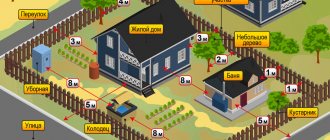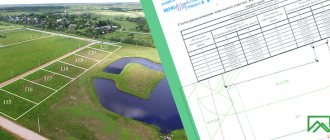What can be considered a land grab?
If the fence is less than 5 cm thick, it is built strictly along the boundary with the neighboring territory.
When erecting a large fence, the builder places it on his own territory or on the boundary, but with the written permission of the neighbor. In the same way, the construction of hedges of blackberries, raspberries, and grapes between sections is possible only by mutual decision. After the boundary signs are put up, it becomes clear that the neighbor has indeed entered my property; something needs to be done if the fence has been moved onto my territory.
Defining boundaries
Before building a fence, your neighbor must review all the land documents and agree on the installation location with you. An act is drawn up confirming the agreements reached. The document becomes a guarantee that the legal procedure was carried out properly and the rights of neighbors were respected.
If one of the neighbors does not agree with the choice of location for installing the fence, you must contact a surveyor. He will study the documents and accurately place boundary markers.
The neighbor must take into account the requirements for the installation site of the fence:
| On the border with neighbors | You cannot install a fence strictly along the boundary from the boundary plan. It should retreat 0.5 m into the site. |
| Along the border along the roadway and pedestrian areas | It is also necessary to set aside space, since installation directly along the border is not allowed. |
| Blind fence | You will have to retreat at least 1 meter |
What applies to public lands
In areas where private development is located, there are several land options:
- state (municipal);
- private;
- common use.
Public land is necessary so that the owners (tenants, users) of land plots can freely use their lands.
In areas of frequent construction and garden plots, public lands include:
- roads of all kinds;
- territories where social and cultural objects are located (parks, public gardens);
- plots designed to meet the needs of residents (common well).
What to do if a neighbor has appropriated public land
However, the ban often does not prevent citizens from appropriating public land. When looking at judicial practice, you can come across a lot of conflicts that are based on the illegal use of common lands.
To solve a problem in the legal field, you must follow the following algorithm:
- Find the owner of the land.
- File an appeal to the land owner.
- Contact Rosreestr to bring the culprit to justice.
- Go to court.
It is believed that in a malicious situation it is possible to recover moral damages from the culprit. In practice, this is almost impossible. It will not be easy to prove moral suffering from the blocked area.
Finding the owner of the land
First of all, it is necessary to confirm that the neighbor is not the legal owner of this site. Perhaps the boundaries of his allotment are set in such a way that the disputed area belongs to his property.
In addition, the citizen had the full right to conclude a lease agreement with the district administration and lease the missing part of the plot for 49 years. Therefore, it is possible that he is using it legally.
To find out the identity of the owner you must:
- Receive an extract from the Unified State Register of Real Estate.
- Check the information against the development plan (the master development plan can be viewed at the local administration).
If the site is not registered in the cadastral register, and lease and use rights do not apply to it, then the owner is the local administration. In this case, the seizure is de facto.
This can be resolved by contacting the owner.
Contact the owner
After receiving documents about the actual seizure of a land plot, you must contact its owner. For example, a road may be owned by:
- HOA;
- local administration;
- in common shared ownership of the THC.
Information about the seizure is provided in writing addressed to the head of the housing cooperative or the head of the local government body. After which, they must take measures to bring the culprit to justice for the illegal seizure of land.
Contact Rosreestr
If the owner refuses or is in no hurry to bring the perpetrators to justice, citizens can also initiate the imposition of administrative punishment. To do this, you need to contact the territorial department of Rosreestr and report the unauthorized seizure of land.
Rosreestr is a government body that is authorized to independently bring land invaders to administrative responsibility.
Important! Contacting the police department regarding issues related to illegal seizure of land will not bring results. The police are not authorized to initiate administrative proceedings on these issues.
Let's go to court
In some cases, legal seizure of land is possible. This is an illegal registration of rights to common land.
For example, on this site there is the only access to the neighbor’s plot, and the culprit has drawn up land surveys or bought the land from the HOA. In this case, the dispute can only be resolved in court.
A citizen whose rights have been violated has the right to file an application for termination of ownership rights, amendments to the Unified State Register of Real Estate and the removal of obstacles to the use of the site.
When going to court, you must prove the following points:
- the land belongs to public territory (land management examination, analysis of cadastral plans of plots and master construction plans);
- actual boundaries do not correspond to official ones (land management examination).
The applicant must establish the following requirements in the claim:
- establish the boundaries of land plots;
- recognize the survey results as incorrect>;
- recognize the transaction as invalid (if the rights to the plot arose on the basis of the purchase of common land from the THC);
- dismantle the fence (if there is a fence).
Landmarking and fencing of the local area
Apartment building. 40 apartments. Ownership rights to residential premises are registered. It was surrounded by a fence! And as it turned out later, 12 years later, the land plot was listed in the cadastral register as for building a house. Result: the fence was dismantled as illegal construction. Now the land is being surveyed, according to an agreement with the residents, to make changes to the cadastre. If changes are made, will it automatically be listed as the shared property of the residents? Yes! And you don’t need to register any more leases and you can, in accordance with the established procedure, restore the fence!
This is interesting: The developer built a residential building less than 3 meters from the adjacent plot
1. The owner has the rights to own, use and dispose of his property. 2. The owner has the right, at his own discretion, to take any actions in relation to his property that do not contradict the law and other legal acts and do not violate the rights and interests protected by law of other persons, including alienating his property into the ownership of other persons, transferring it to them, while remaining the owner , the right to own, use and dispose of property, pledge property and encumber it in other ways, dispose of it in any other way.
What should I do if, during land surveying, it turns out that the neighbors have climbed onto my property?
In practice, disagreements often arise between the owners of adjacent plots after the land surveying procedure. If, after carrying out surveying work that established the boundaries of your plot, you believe that part of your plot has been captured by a neighbor, check the data in the cadastral passport with the results obtained during the surveying work.
Carry out a number of the following actions:
- According to the rules for establishing the boundaries of land management objects on the ground, approved by Decree of the Government of the Russian Federation No. 688, the boundaries of land management objects are established on the ground in accordance with cadastral data on such objects. The state cadastre contains information about the coordinates of characteristic boundary points (points with the help of which the description of boundaries can be changed or divided into parts), along which the boundaries of a land management object are established. Consequently, it is necessary to establish turning points and boundary markers, information about which is in the cadastre and serves as the boundaries of the land plot. Do not forget that these works can only be carried out by a company specializing in land management and having the appropriate license;
- After receiving information about the boundaries, begin to negotiate with the people who own the neighboring plots. Based on the information received, it is possible to determine the location of the borders and the presence of a violation, expressed in the seizure of part of the site. If you have a well-founded argument, your chances of resolving the conflict pre-trial based on an oral agreement with your neighbors increase significantly;
- If you cannot reach a compromise with your neighbors, go to court. It will be necessary to restore the situation that existed before the violation of rights. According to Article 61 of the Land Code of the Russian Federation, the subject of the claim is the recognition of the border between plots established on the basis of the coordinates of characteristic turning points, as well as the restoration of the past boundaries of your plot.
Do not forget that when filing a claim, you must have the appropriate rights to a piece of land, according to which you can demand that the boundaries be agreed upon.
Such rights include, first of all, the right of ownership, as well as the right of permanent use and lifelong possession, the right to lease a plot that is in state or municipal ownership, if the term of such lease exceeds five years.
The onus is on you as the applicant to verify the trespass. To confirm, provide a cadastral passport and information about the land survey of your site.
We are trying to come to an agreement
First, try talking to your neighbor. You can't walk alone! Take two reliable people with you. Their testimony can be used in the future in court, especially if the neighbor behaves incorrectly. Witnesses will also be useful if the enemy tries to blame you for aggressive actions.
The offender is counting on you not to “mess with” him and seek the truth. At this stage, you need to clearly define your position. Make it clear that you will go to the end in search of justice!
If it was not possible to resolve the situation in this way, we proceed further.
We contact the chairman of the partnership
Is your plot part of a non-profit gardening partnership? Submit a written request to the chairman. Of course, he cannot make any decisions. Just like you can’t force your neighbor to remove the fence from your property.
Acting as a disinterested third party, he will conduct a preventive conversation with your opponent. At this stage it is good to give examples of similar disputes and their results. It is important to describe the situation so that the neighbor understands that he will remain “in the red.” For example, that he will face forced dismantling, payment of a fine, legal costs and examinations.
If after this the neighbor does not give up his plan, we move on to something more complex.
We make a request to the administration
Before you begin active opposition, make sure you are right. To do this, send a written request to the district administration. Wait for an official response to your problem. Perhaps it will contain information previously unknown to you that will radically change the situation.
Submit a complaint to the state land supervision
You must submit a written application to the territorial authority at your location. Land supervision is part of Rosreestr. Its functions include identifying and suppressing violations in the use of land plots.
The inspector has the right to conduct inspections and issue orders to eliminate identified violations. Most likely, he will impose a fine on the offender.
Complaining can work if you have a boundary plan. In its absence, additional surveying will be necessary. It may turn out that your neighbor carried out the procedure for determining boundaries without your approval. In this case, the only thing left to do is go to court.
We're suing
An application to establish the boundaries of a land plot is submitted to the district court at the location of the land. Even if you make a mistake and apply to the “wrong” place, the court will issue a refusal order. It will indicate the authority where the documents should be submitted.
To speed up the trial, try to collect as much evidence as possible. Enlist the help of witnesses.
Be sure to include copies of:
• certificates of ownership;
• cadastral extract with plan (ordered from Rosreestr or MFC);
• explanations from the administration;
• boundary plan;
• regulations of land supervision.
The proceedings may take a long time. Most often, the deadlines are increased when examinations are carried out or the defendant files motions to postpone the hearings.
If the decision is not in your favor, file an appeal. In particularly complex cases, litigation can last for several years.
Correct claim
It is important to consider that a claim against a neighbor about seizing land and moving the fence is only possible if you have legal documents for your own plot. After the visit of the cadastral engineer and the establishment of turning points, the chances of a quick resolution of the conflict increase. If the neighbor did not initially take action to cause damage, then a sensible law-abiding citizen will return the fence to its original place and the conflict will be settled.
Otherwise, the actions of the neighbor are subject to administrative punishment and a fine in the amount of 1.5-2% of the cadastral value of the site, but not less than 5.0 thousand rubles. If a neighbor has taken a significant part of the territory, then the fine charged is proportional to its area.
Going to court in accordance with Article 61 will help you restore your rights to a strip of land. Land Code of the Russian Federation with a request to recognize the boundary between plots based on the coordinates of characteristic turning points and the boundaries that the plot had previously.
Important. When going to court, the applicant is obliged to present a passport and, with the help of documents, prove his rights to the disputed territory, to do this, present a copy of the boundary plan, a conclusion, and a certificate of ownership. Testimony from witnesses will be helpful.
The claim must disclose in detail the following issues:
- Description of the documentation on the basis of which the applicant uses the land plot.
- Under what circumstances was the violation discovered?
- Characteristics of the violation.
- Describe. what actions were taken to restore their rights to the site.
- Indicate what actions the neighbor took in response.
- A list of documents and copies is provided.
It is very difficult to resolve an issue with a neighbor on your own. It is recommended to engage a lawyer who will negotiate and, if necessary, draw up a statement of claim.
We turn to the bailiffs
It happens that, having lost a case, a neighbor does not comply with a court decision to move the fence. In such a situation, contact the bailiff service at your location. There they will initiate enforcement proceedings and issue another ruling to the dull neighbor. If he ignores this order, the bailiff will ensure that the fence is dismantled by the FSSP.
Illegal seizure of land by a neighbor is one of those situations in which it is better not to get into. We wish those who have to fight for their rights good luck, patience and a positive outcome!
When to go to court if a neighbor has seized part of the land?
In some cases, for example, when there is a dispute over the boundaries of a site, it is necessary to go to court (the Municipality will not help).
We, land lawyers, have extensive experience in dealing with such disputes. In order to understand how to act specifically in your situation, we schedule a consultation in the office with documents. At this consultation, we review documents and discuss your case in detail. We discuss the possibility of resolving your issue through the court or pre-trial, the likelihood of success of the court case, the difficulties and risks of this lawsuit, whether or not an examination will be carried out in the court process, the timing of the trial, and other features of the court case.
We lawyers are practitioners. We can take on all the work related to your dispute in court. From drawing up a statement of claim to receiving a writ of execution and monitoring enforcement proceedings at the very end of your land dispute.
Ask a question, we are online!
Leave a message!
+7 (812) 313-2-106 services of land lawyers in St. Petersburg
July 22, 2020.
Situation: a neighbor put up a fence and seized someone else's land
Since the fence is installed along the border of the plots, it is necessary to agree on its location by both neighbors. At the same time, cadastral plans of neighboring areas are carefully studied. But this will only work if the boundaries of the plots are defined and clarified, and the lands themselves are registered in the cadastral register and displayed on a public cadastral map.
If land surveying has not been carried out, it will have to be done with the help of a cadastral engineer. He also determines the correct location of the border of two sections. You can read about how to do land surveying here.
But fences are moved not only in areas without land surveying, but also in already demarcated areas. In such a situation, there is no need to rush to court or run to the local police officer with a complaint. The correct algorithm would be:
- check whether a violation actually occurred - it is better to invite a cadastral engineer for these purposes, since it is difficult to measure distances on your own;
- verbally inform your neighbor about the imposition of boundaries and the illegal seizure of the territory of your site;
- present to your neighbor a cadastral plan with marked boundaries and indicate the actual violation;
- If there is no response from your neighbor, you must file a complaint with Rosreestr.
Important! The fence may end up on your property during land surveying. You can learn how to act when imposing boundaries in this article.
Neither the local police officer nor the court are needed at the “early stages”. Everything is decided at the level of state inspectors for the use and protection of land. To attract them, you need to send an application to Rosreestr, which indicates:
- the address of the site whose territory the neighbor has invaded;
- cadastral number of the land plot;
- information about the transfer (installation) of the fence, which led to a violation of property rights.
Specialists conduct an inspection upon the complaint and issue an order to eliminate the violation. The culprit is subject to an administrative fine of 1-1.5% of the cadastral value of the annexed plot, but not less than 5,000 rubles.
The neighbor who installed the fence is given no more than 6 months to correct the violation. If he does not meet these deadlines, but is working on a correction, they may be extended. Well, if the order is ignored, the fine will be re-imposed.
But what if a violation is not detected, but in fact it exists? Since there are no hopeless situations, you can force him to return the fence to its place in such a situation.
What to do if neighbors in the area are blocking the passage to the house
At the same time, it turned out that the passage was closed for the neighbor; he could not get to his site due to the erected fence. It turns out that for many years the owner of the site to which the passage was blocked moved through someone else's territory without having the right to do so. In such a situation, it is useless to challenge the position of the boundaries determined by the cadastral engineer in the process of land surveying. It is necessary to try to establish an easement if the owner of an isolated plot of land cannot find another way to the site.
This is interesting: Registration of large families if one child is registered with her ex-husband but lives with her mother
At the same time, the boundaries are tied to objects of natural origin and to the site restrictions erected by the owners. Such restrictive landmarks can be trees, bushes, or a fence.
Situation: a neighbor put up a fence, the authorities do nothing
State inspectors do not always carefully check the removal of fences. And in the case of a complex and broken boundary of plots, they can leave the situation unchanged, notifying about the absence of violations. In this case, lawyers advise hiring a cadastral engineer who will point out the discrepancies between the cadastral boundary and the actually installed fence.
The received report can be sent as an attachment to the complaint to the prosecutor's office. You will have to complain about the state inspectors. If the outcome of the complaint is positive, the money for the cadastral engineer will not be returned, but the border will most likely be returned to its proper place.
Consequences of land seizure for the trespasser
Liability in cases of seizure of a land plot or part thereof is provided for in Art. 7.1 Code of Administrative Offenses of the Russian Federation. The amount of the fine depends on the status of the violator and the cadastral value of the land (if it is established at all):
| Amount of fine, rub. | ||
| CS installed | CS not installed | |
| For citizens | 1-1.5% KS, min. 5,000 | 5 000-10 000 |
| For officials | 1.5-2% KS, min. 20,000 | 20 000-50 000 |
| For organizations | 2-3% KS, min. 100,000 | 100 000-200 000 |
The exact amount of the fine when occupying plots with a certain cadastral value is calculated in proportion to the illegally occupied area. If the violator is an entrepreneur, he pays a fine according to the tariffs for organizations (even if he actually works without forming a legal entity).
In addition to administrative liability, the neighbor will be required (depending on the situation):
- return the seized part of the territory to the rightful owner;
- restore the boundaries of the plots according to the land survey data;
- demolish/dismantle structures built on someone else's land>;
- pay an additional fine for erecting unauthorized buildings.
Responsibility for squatting of land
The mildest punishment for violating land legislation is the confiscation of land from the invader and its return to the rightful owner. In addition, an administrative fine may be imposed on the culprit.
The amount of penalties depends on the area of the assigned plot and the category to which the violator belongs. Thus, citizens are required to pay 1-1.5% of the cadastral price of the territory, but not less than 5,000 rubles. In case of land seizure by a legal entity, the amount of payments will be 2-3%, but not less than 100,000 rubles. If the cadastral value is not determined, the fine varies from 5,000 to 10,000 rubles. for individuals and from 100,000 to 200,000 rubles. for companies.
PRO new building (Moscow)
- Require documents that would confirm the existence of legal grounds for the construction of the structure;
- Carry out registration of the already erected structure in accordance with all standards and taking into account the interests of the owners of apartments in the building;
- When the requirements of the second paragraph are not met, such a fence will be demolished. There is no point in doing this on your own; this is carried out by special authorities.
Every person wants to live in a calm and cozy place where he will not worry about the safety of his children. Due to this, the desire among residents of houses, through whose yard there is a constant flow of cars and people, to isolate themselves is quite understandable. However, according to the law, not all types of barriers can be used.
This is interesting: Who Buys Combat Veteran Certificates
Arbitrage practice
As judicial practice shows, it is not so easy to prove a violation of boundary boundaries with a plot belonging to a neighbor. The court takes into account not only the fact of violation of boundaries, but also the existence of agreements with the previous owner of the site, the established order of land use.
Most often, heirs find themselves in this situation. Having inherited a land plot, the newly-minted owners try to defend their rights. However, the established order of land use between the owner and the testator is of significant importance in legal practice.
Example . Nelya inherited a house and land from her grandfather. To move the whole family into the house, it was necessary to carry out reconstruction. The girl received the necessary permits and began construction. However, the neighbors' garage, located on her property, disrupted the plans. She went to court to force the neighbors to demolish the garage and install a fence along the property line. The girl tried to negotiate with her neighbors to move their garage. They refused. The heiress attracted the local administration. The decision of the interdepartmental commission decided that the neighbors' garage was built in violation of the boundary line. The defendant explained in court that the construction was agreed upon with the previous owner. And when carrying out land surveying, both parties agreed to this arrangement of buildings. This order is considered to be the established order of land use, to which the previous owners agreed. Therefore, the court rejected Nele’s claim.
In 2020, a unified judicial practice on the issue of unauthorized seizure of land has not been formed. Therefore, courts often make completely unexpected decisions.
Example . Natalya filed a complaint with the court about the unauthorized seizure of part of the plot. A neighbor erected an iron carport that blocks the light in one of her rooms. The canopy slope will be located on its territory, so water from the roof flows onto the blind area and wall of the house. Exposure to water leads to the destruction of the wall. In her requirements, Natalya asked to install a fence at the border of the plots, and move the extension 1 meter from the fence. The court granted the request to move the fence. However, he considered the requirement for permission to build to be groundless. Since Natalya did not provide evidence of the negative impact from the roof slope. Therefore, compulsion to move the shed was refused.
What to do if neighbors move the fence
- the opaque barrier should be up to 75 cm;
- higher fences only made of transparent materials that do not block the sun;
- by agreement with the neighbors, a blind fence of any height can be built;
- buildings should be located at least 1 meter from the fence: tall trees and a 3-story house - 2 meters.
If it is impossible to calmly pass by from the street to a neighbor’s property, a small strip of 75 centimeters is allocated for such a path, which legally belongs to the owner, but in fact cannot be used in any other way other than as a passage. Accordingly, such land cannot be fenced.
10 Jun 2020 lawurist7 185
Share this post
- Related Posts
- What Bailiffs Cannot Arrest Under Civil
- Buy a Completed Combat Veteran Certificate
- The Cost of a Pension Point in 2020 and the Fixed Payment to It
- Vacancies in Moscow From Direct Employers From 60,000 Rubles For Men Shift
Why is it recommended to register land plots and carry out land surveying?
Cadastral registration and registration of rights are of a declarative nature. This means that the law does not oblige citizens to register real estate properties they own, and these procedures can only be carried out at the request of their owners.
But if you are the owner of a plot and want to dispose of it, for example, sell, donate or inherit, then you need to register the plot with the cadastral register and register ownership rights to it. Therefore, Rosreestr recommends that citizens register plots in accordance with the law. The agency also recommends that owners of plots that do not have precise boundaries consider carrying out cadastral work - land surveying. Entering information about borders into the Unified State Register will save you from problems due to possible disputes.
Sources
- https://prososedey.ru/v-chastnom-sektore/sosed-zalez-na-moj-uchastok.html
- https://pravo-doma.ru/zemlya/chto-delat-esli-sosedi-postavili-zabor-na-moem-uchastke.html
- https://allo-urist.com/zemlya-obshhego-polzovaniya-mezhdu-sosedyami/
- https://UrOpora.ru/zemlya/pri-mezhevanii-vyyasnilos-chto-sosedi-zalezli-na-moj-uchastok.html
- https://zen.yandex.ru/media/sadovichok/sosed-zahvatil-chast-zemelnogo-uchastka-chto-delat-5c6efb2203b2f900af5bd8a7
- https://Pravda-Zakona.ru/article/stroitelstvo-zaborov-sosedyami.html
- https://law-divorce.ru/chto-delat-esli-sosed-zahvatil-chast-zemelnogo-uchastka/
- https://Yur01.com/landlaw/sosed-nezakonno-zahvatil-chast-zemelnogo-uchastka-chto-delat-kuda-obraschatsya-sudebnaya-praktika
- https://allo-urist.com/chto-delat-esli-sosed-zahvatil-chast-zemelnogo-uchastka/
- https://rg.ru/2019/05/28/chto-delat-esli-sosed-postavil-svoj-zabor-na-vashem-uchastke.html
[collapse]






